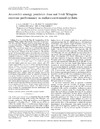Identificador persistente para citar o vincular este elemento:
https://accedacris.ulpgc.es/jspui/handle/10553/6570
| Título: | Anaerobic energy provision does not limit Wingate exercise performance in endurance-trained cyclists | Autores/as: | Calbet, JAL De Paz, J.A. Garatachea, N. Cabeza de Vaca, S. Chavarren Cabrero, Javier |
Clasificación UNESCO: | 241106 Fisiología del ejercicio | Palabras clave: | Hypoxia Oxygen deficit Wingate Sprint |
Fecha de publicación: | 2003 | Publicación seriada: | Journal of Applied Physiology | Resumen: | The aim of this study was to evaluate the effects of severe acute hypoxia on exercise performance and metabolism during 30-s Wingate tests. Five endurance- (E) and five sprint- (S) trained track cyclists from the Spanish National Team performed 30-s Wingate tests in normoxia and hypoxia (inspired O(2) fraction = 0.10). Oxygen deficit was estimated from submaximal cycling economy tests by use of a nonlinear model. E cyclists showed higher maximal O(2) uptake than S (72 +/- 1 and 62 +/- 2 ml x kg(-1) x min(-1), P < 0.05). S cyclists achieved higher peak and mean power output, and 33% larger oxygen deficit than E (P < 0.05). During the Wingate test in normoxia, S relied more on anaerobic energy sources than E (P < 0.05); however, S showed a larger fatigue index in both conditions (P < 0.05). Compared with normoxia, hypoxia lowered O(2) uptake by 16% in E and S (P < 0.05). Peak power output, fatigue index, and exercise femoral vein blood lactate concentration were not altered by hypoxia in any group. Endurance cyclists, unlike S, maintained their mean power output in hypoxia by increasing their anaerobic energy production, as shown by 7% greater oxygen deficit and 11% higher postexercise lactate concentration. In conclusion, performance during 30-s Wingate tests in severe acute hypoxia is maintained or barely reduced owing to the enhancement of the anaerobic energy release. The effect of severe acute hypoxia on supramaximal exercise performance depends on training background. | URI: | https://accedacris.ulpgc.es/handle/10553/6570 | ISSN: | 8750-7587 | DOI: | 10.1152/japplphysiol.00128.2002 | Fuente: | Journal Of Applied Physiology[ISSN 8750-7587],v. 94 (2), p. 668-676 |
| Colección: | Artículos |
Vista completa
Citas SCOPUSTM
162
actualizado el 08-jun-2025
Citas de WEB OF SCIENCETM
Citations
152
actualizado el 08-jun-2025
Visitas
109
actualizado el 24-ago-2024
Descargas
436
actualizado el 24-ago-2024
Google ScholarTM
Verifica
Altmetric
Comparte
Exporta metadatos
Este elemento está sujeto a una licencia Licencia Creative Commons

